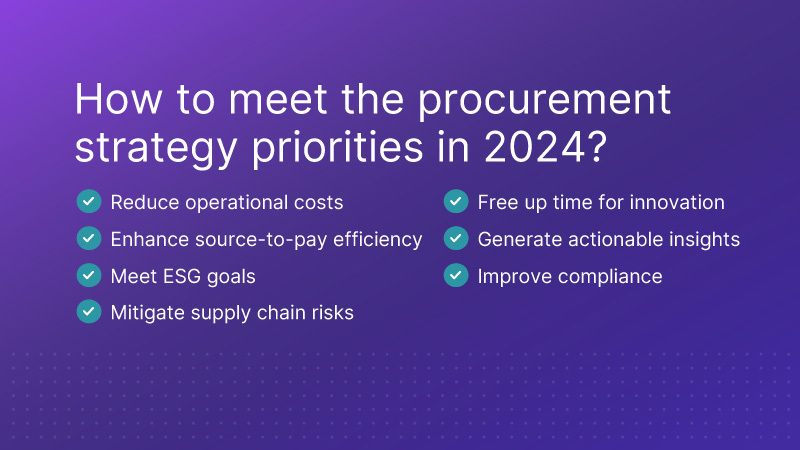
7 Priorities to Unlock Procurement Excellence in 2024


Procurement is poised for a significant transformation this year, guiding chief procurement officers (CPOs), procurement managers, and supply chain executives towards new priorities and challenges. The recent Worldwide Business Research (WBR) report outlines seven critical priorities for CPOs to address in 2024. These priorities demonstrate that procurement’s role extends beyond cost reduction and operational efficiency.
The focus must shift towards comprehensive goals encompassing supply chain risk mitigation, innovative growth, environmental, social, and governance (ESG) objectives, and more. As procurement functions evolve into strategic enablers of business growth, addressing these priorities is essential for CPOs to maintain relevance and drive success. Let’s explore these seven procurement strategies in detail.
Procurement Strategy 1: Reducing Operational Costs
Cost reduction remains a top priority in 2024. However, it demands a more nuanced approach than simple price negotiations. CPOs must adopt a holistic perspective that encompasses the total cost of ownership, understanding suppliers’ production costs, and mastering demand management.
To achieve this, CPOs should cultivate a culture of robust negotiation preparation and in depth market and supplier understanding within their teams. By shifting focus from cost cutting measures to optimizing specifications and volumes, procurement teams can reduce operational costs while enhancing value creation.
Procurement Strategy 2: Mitigating Supply Chain Risks
The current global landscape, marked by events like the ongoing Ukraine and Middle East conflicts and fluctuating macroeconomic factors, has brought supply chain risk mitigation to the forefront of procurement concerns. Disruptions can have severe consequences for businesses, leading to operational inefficiencies, lost productivity, and diminished competitiveness.
To reduce these risks, CPOs need to shift from reactive risk management approaches to proactive strategies that identify potential risks before they materialize. This proactive approach involves predictive analysis of market trends, supplier performance, geopolitical factors, and industry developments. By identifying risks early, procurement teams can implement preventative measures, safeguarding the supply chain and enhancing overall operational efficiency.
Procurement Strategy 3: Generating Actionable Insights
Procurement teams now have access to an abundance of information. However, the key challenge lies in making sense of it and extracting actionable insights that drive strategic decision making. CPOs should incorporate advanced analytics and insight generation techniques into their procurement processes.
With a deep understanding of market trends, supplier performance, risk factors, and opportunities for innovation, they can make data driven decisions that align strategically with the organization’s broader goals. This approach enhances strategic alignment, improves risk management, and facilitates the identification of innovation opportunities.
Procurement Strategy 4: Enhancing Source to Pay Efficiency
Many organizations struggle with lengthy and inefficient source to contract processes, leading to delays and bottlenecks. To address this, CPOs need to target a nimble, agile source to pay process that streamlines requirement gathering, sourcing, negotiation, and contract finalization.
Improving source to pay efficiency offers significant advantages, including reducing the time required to onboard suppliers, ensuring a quicker response to business needs, and enabling organizations to adapt more rapidly to market changes and seize new opportunities.
Procurement Strategy 5: Freeing Up Time for Innovation
Innovation is essential for maintaining a competitive edge. However, procurement teams often find themselves consumed by routine tasks and standard processes, leaving little time for exploring new opportunities and fresh ideas.
To address this challenge, CPOs should aim to automate and optimize routine procurement processes. By leveraging technology and streamlining operations, they can free up valuable time and resources. This allows procurement teams to focus on strategic activities, such as researching new market trends, developing innovative supplier relationships, and uncovering new avenues for value creation.
Procurement Strategy 6: Meeting ESG Goals
CPOs must gain a deep understanding of the materials they procure, tracing them back to their origins, including ores, water, and other basic components. This material level visibility allows them to assess the sustainability and environmental impact of their supply chain. It also enables them to identify and reduce risks related to material shortages, thereby making procurement decisions that genuinely reflect their commitment to ESG principles.
Procurement Strategy 7: Improving Compliance
Recent regulations such as the EU Emissions Trading System (ETS), Carbon Border Adjustment Mechanism (CBAM), and the US AI Regulation have placed increased emphasis on compliance and its impact on ESG performance. To tackle this challenge, CPOs should aim to simplify and automate compliance processes, reducing the risk of errors and non compliance. By integrating compliance into procurement processes and adopting technological solutions for compliance checks, risk assessments, and reporting, procurement teams can ensure consistent adherence to regulations and standards. This approach improves corporate governance and builds trust among stakeholders, including suppliers, customers, and regulatory bodies.
Navigating the Path to Procurement Excellence
These seven procurement strategies present both challenges and opportunities. To navigate them effectively, procurement leaders must embrace a strategic mindset, leverage data-driven insights, and adopt innovative approaches and technologies.
Beroe: Your Partner in Procurement Transformation
Beroe offers a comprehensive suite of solutions designed to support CPOs in addressing these priorities. From advanced market intelligence and predictive analytics to automated compliance tools and strategic advisory services, Beroe’s offerings enable procurement teams to streamline operations, mitigate risks, and drive sustainable value creation. Key solutions include real-time market data access, category strategy and management tools, supply market intelligence, risk identification and management solutions, and compliance monitoring systems.
By partnering with Beroe, CPOs can gain a competitive edge, transforming their procurement functions into strategic enablers of business growth and long-term success.
Embark on Your Journey to Procurement Excellence Today
Are you ready to tackle the procurement challenges of 2024 and position your organization for success? Reach out to Beroe today to explore our tailored solutions and receive expert guidance on implementing these strategies within your organization.
Visit our website [insert link] to learn more about our procurement intelligence and data analytics services, as well as our advisory services focused on cost optimization, risk management, sustainability, and compliance.
Related Insights:
View All
Get more stories like this
Subscirbe for more news,updates and insights from Beroe






